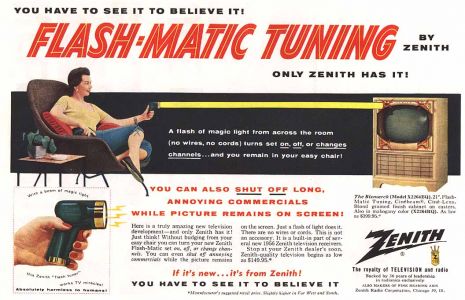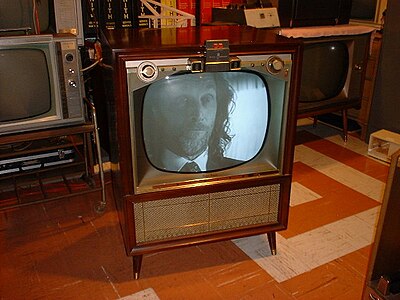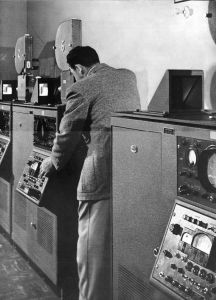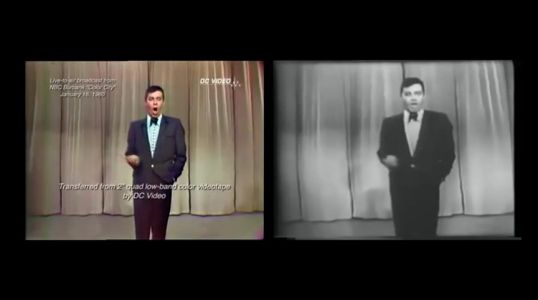Difference between revisions of "A History of TV Style (Discussion)"
From Screenpedia
Jump to navigationJump to search (TCF - JCM) |
|||
| (11 intermediate revisions by 2 users not shown) | |||
| Line 2: | Line 2: | ||
#Explain the concept that goes by the terms, "technological manifest destiny" and "technological determinism." Why is it a ''mistaken'' notion when applied to TV? | #Explain the concept that goes by the terms, "technological manifest destiny" and "technological determinism." Why is it a ''mistaken'' notion when applied to TV? | ||
#*What are some examples that you've seen that prove this concept is wrong? (Don't rely on the examples in the book and you can refer to technology other than that involving video or TV.) | #*What are some examples that you've seen that prove this concept is wrong? (Don't rely on the examples in the book and you can refer to technology other than that involving video or TV.) | ||
| − | |||
| − | + | ''' Groups 4 & 8''' | |
| − | |||
| − | |||
| − | |||
| − | |||
| − | |||
| − | |||
| − | |||
| − | |||
| − | ''' | ||
#Outline the history of TV editing--listing the major technological changes. How did these changes have an impact on TV style? | #Outline the history of TV editing--listing the major technological changes. How did these changes have an impact on TV style? | ||
| − | #*Manual editing | + | #*Manual film editing |
| − | #*Manual editing | + | #*Manual videotape editing |
| − | #*Editech | + | #*Editech (first electronic editing) |
| − | #* | + | #*Nonlinear editing on computer (Avid, Premiere, etc.) |
#Why type of editing equipment do you suppose was used to cut the following programs: | #Why type of editing equipment do you suppose was used to cut the following programs: | ||
| − | #*''All My Children'': | + | #*''All My Children'': videotape editing |
| − | #*''Northern Exposure'': | + | #*''Northern Exposure'': film editing |
| − | #*''Seinfeld'': | + | #*''Seinfeld'': film editing |
| − | #*'' | + | #*''Stranger Things'': Red camera, digital recording at 6K; then edited nonlinearly |
| − | ''' | + | '''Groups 5 & 1''' |
#List the elements of the production of ''I Love Lucy'' that make it significant to the history of TV style. Explain ''why'' each element is important. | #List the elements of the production of ''I Love Lucy'' that make it significant to the history of TV style. Explain ''why'' each element is important. | ||
| − | # | + | ##Studio audience |
| − | # | + | ##Multiple-camera mode of production |
| − | + | ##Shot and distributed on film (higher quality) | |
| − | # | + | ##DesiLu produced and owned the show in syndication |
| − | |||
| − | # | ||
| − | # | ||
| − | # | ||
| − | # | ||
| − | ''' | + | '''Groups 6 & 2''' |
#The history of color TV is very complicated. Create a timeline that lists the significant events leading up to color TV's widespread implementation. | #The history of color TV is very complicated. Create a timeline that lists the significant events leading up to color TV's widespread implementation. | ||
| − | #*1946 CBS | + | #*1946: CBS hybrid (mechanical-electronic) color TV |
| − | #*1950: FCC | + | #*1950: FCC approves hybrid as official |
| − | #*1951: | + | #*June 1951: CBS broadcasts in color |
| − | #*1954: RCA | + | #*Nov 1951: they stop |
| − | #*1966: | + | #*Dec 1953: National Television Systems Committee (NTSC) sets color standard, as RCA/NBC tech |
| + | #*1954: RCA manufactures home color TV sets | ||
| + | #*1966: CBS start using the NBC system; color broadcasting becomes dominant | ||
#What impact did color technology have on TV style? | #What impact did color technology have on TV style? | ||
#What is the NTSC and why was it created? | #What is the NTSC and why was it created? | ||
| − | |||
| − | ''' | + | '''Groups 7 & 3''' |
#When did the remote control first appear and what were the names of the early devices? | #When did the remote control first appear and what were the names of the early devices? | ||
#*How did they work? | #*How did they work? | ||
#How do modern remote controls work and when did they become commonly used? | #How do modern remote controls work and when did they become commonly used? | ||
| − | #What have broadcast networks done to try to combat | + | #What have broadcast networks done to try to combat channel changing and distractions from "second screens" (that is, cellphones, tablets, laptops)? |
| + | |||
| + | '''Early Remote Controls''' | ||
| + | <gallery mode="packed" heights=200px> | ||
| + | File:1956 Zenith Remote Ad.JPG|alt=Zenith remote-control ad (1956).|Zenith remote-control ad (1956). | ||
| + | File:Zenith Space Command.jpg|alt=Zenith Space Command remote control unit.|Zenith Space Command remote control unit. | ||
| + | File:56zenith.jpg|alt=Zenith Space Command receiving TV set (1957).|Zenith Space Command receiving TV set (1957). | ||
| + | File:Toshiba Remote Control CT-9863.jpg|alt=A Toshiba remote control, photographed in 2009.|A Toshiba remote control, photographed in 2009. | ||
| + | </gallery> | ||
| + | |||
| + | '''Kinescope (all groups, if time permits)''' | ||
| + | #What is a kinescope? How were kinescopes created and what characterized how they looked? | ||
| − | + | '''Kinescope Illustrations''' | |
| − | + | <gallery mode="packed" heights=200px> | |
| − | + | File:Dumont Kinescope Machines.jpg|alt=Dumont Kinescope Machines.|Dumont Network kinescope machines. | |
| − | + | File:Jerry Lewis Show 1960 - Footage Comparison.jpg|alt=Screen shots from The Jerry Lewis Show.|[http://tcf.ua.edu/EO/DV/Kinescope-TapeComparison.php Screen shots from ''The Jerry Lewis Show''.] | |
| − | + | </gallery> | |
| − | |||
| − | |||
| − | |||
| − | |||
| − | |||
| − | |||
== Bibliography == | == Bibliography == | ||
| Line 71: | Line 62: | ||
==External links== | ==External links== | ||
*[http://tcf.ua.edu/EO/DV/Kinescope-TapeComparison.php Kinescope-Videotape comparison] | *[http://tcf.ua.edu/EO/DV/Kinescope-TapeComparison.php Kinescope-Videotape comparison] | ||
| − | *[http://www.tcf.ua.edu/EO/DV/Clorox. | + | *[http://www.tcf.ua.edu/EO/DV/Clorox.php Clorox commercials]. |
| − | *[ | + | *[https://tcf.ua.edu/EO/DV/Laughin19680914.php ''Rowan & Martin's Laugh-In''] (episode 15, 9/16/1968) |
*[http://youtu.be/gV0Ralac0w4 ''The Magic of Television''] (1941) | *[http://youtu.be/gV0Ralac0w4 ''The Magic of Television''] (1941) | ||
| − | [[Category: | + | [[Category:JCM311]] |
| − | [[Category: | + | [[Category:JCM311 Discussion]] |
Latest revision as of 21:48, 23 August 2019
All groups
- Explain the concept that goes by the terms, "technological manifest destiny" and "technological determinism." Why is it a mistaken notion when applied to TV?
- What are some examples that you've seen that prove this concept is wrong? (Don't rely on the examples in the book and you can refer to technology other than that involving video or TV.)
Groups 4 & 8
- Outline the history of TV editing--listing the major technological changes. How did these changes have an impact on TV style?
- Manual film editing
- Manual videotape editing
- Editech (first electronic editing)
- Nonlinear editing on computer (Avid, Premiere, etc.)
- Why type of editing equipment do you suppose was used to cut the following programs:
- All My Children: videotape editing
- Northern Exposure: film editing
- Seinfeld: film editing
- Stranger Things: Red camera, digital recording at 6K; then edited nonlinearly
Groups 5 & 1
- List the elements of the production of I Love Lucy that make it significant to the history of TV style. Explain why each element is important.
- Studio audience
- Multiple-camera mode of production
- Shot and distributed on film (higher quality)
- DesiLu produced and owned the show in syndication
Groups 6 & 2
- The history of color TV is very complicated. Create a timeline that lists the significant events leading up to color TV's widespread implementation.
- 1946: CBS hybrid (mechanical-electronic) color TV
- 1950: FCC approves hybrid as official
- June 1951: CBS broadcasts in color
- Nov 1951: they stop
- Dec 1953: National Television Systems Committee (NTSC) sets color standard, as RCA/NBC tech
- 1954: RCA manufactures home color TV sets
- 1966: CBS start using the NBC system; color broadcasting becomes dominant
- What impact did color technology have on TV style?
- What is the NTSC and why was it created?
Groups 7 & 3
- When did the remote control first appear and what were the names of the early devices?
- How did they work?
- How do modern remote controls work and when did they become commonly used?
- What have broadcast networks done to try to combat channel changing and distractions from "second screens" (that is, cellphones, tablets, laptops)?
Early Remote Controls
Kinescope (all groups, if time permits)
- What is a kinescope? How were kinescopes created and what characterized how they looked?
Kinescope Illustrations
Bibliography
- Gary Copeland, "A History of Television Style," in Jeremy G. Butler, Television: Critical Methods and Applications, third edition. Not included in fourth and subsequent editions of Television.
External links
- Kinescope-Videotape comparison
- Clorox commercials.
- Rowan & Martin's Laugh-In (episode 15, 9/16/1968)
- The Magic of Television (1941)





